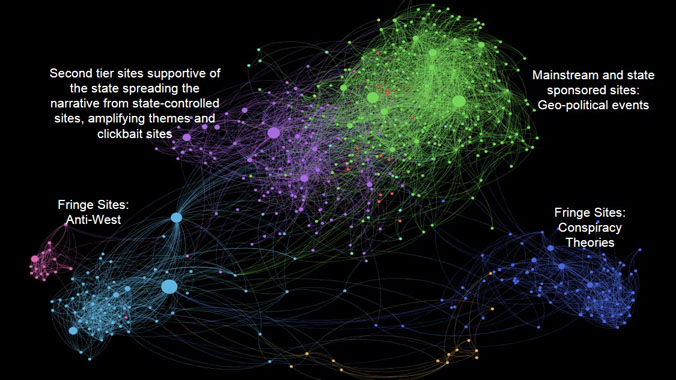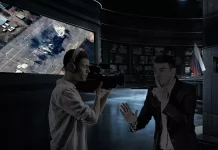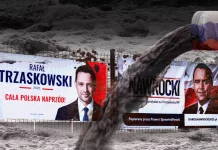By NATO
Introduction
COVID-19 has affected almost every person in every NATO state. It is vital that this global health crisis does not turn into a global security crisis as well.
NATO has demonstrated that it can sustain its operations, missions and activities, and maintain readiness despite the pandemic. The Alliance is now preparing for a possible second wave of COVID-19 with an operation plan, a stockpile of medical supplies and funding, while also strengthening the resilience of our societies. That is because international organisations such as NATO, as well as NATO Allies and partners, have faced a proliferation of disinformation, propaganda and misinformation during the pandemic.
NATO views disinformation as the deliberate creation and dissemination of false and/or manipulated information with the intent to deceive and/or mislead. Disinformation seeks to deepen divisions within and between Allied nations, and to undermine people’s confidence in elected governments. The Alliance has been dealing with these challenges since its inception and has been actively countering a significant increase in disinformation and propaganda since Russia illegally annexed Crimea, Ukraine, in 2014.
NATO has intensified efforts to counter disinformation, following clear direction from Allied Heads of State and Government in the 2018 Brussels Summit Declaration, which stated: “We face hybrid challenges, including disinformation campaigns and malicious cyber activities.” In 2019, in their London Declaration, Allied Heads of State and Government said that NATO is “strengthening [its] ability to prepare for, deter, and defend against hybrid tactics that seek to undermine our security and societies.”
NATO is responding in a unified manner, working in close cooperation with Allies and partners. NATO acts in a measured and responsible way, countering disinformation with fact-based, credible public communications. NATO publicly refutes false claims, debunks the main disinformation narratives aimed at the Alliance and coordinates to share information, insight and best practice.
NATO also works with the European Union, the United Nations, the G7 and civil society to counter disinformation. A free and independent media is the best response to disinformation and propaganda, with journalists free to ask tough questions and check their sources.
COVID-19 has focused the attention of many to the ongoing challenge of disinformation, propaganda and misinformation and the potential harm it can inflict. In a pandemic, facts and clear communications can save lives. They are essential to maintain public safety and uphold NATO’s shared values of freedom, democracy and the rule of law. By working together, NATO Allies and partners are making our societies more resilient and our people safer.
NATO’s approach: Understand and Engage
NATO’s approach to countering disinformation involves a twin-track model, focused on the ‘Understand’ and ‘Engage’ functions.
The Understand function encompasses Information Environment Assessments, which regularly track, monitor and analyse information relevant to NATO’s mission. This enables NATO to evaluate the effectiveness of its communications.
The Engage function embeds these insights, enabling NATO to tailor its strategic communications where it will most effectively counter disinformation.
NATO’s communications are fact-based, timely, transparent and coordinated. This allows NATO to have an impact in a contested information space.
Coordination with Allies and partners is the cornerstone of all NATO’s work both to understand the information environment and to engage audiences. This is particularly important when dealing with a fast-moving crisis such as the COVID-19 pandemic. It is crucial for NATO that nations, other international organisations, such as the EU, as well as civil society and the private sector, work together to build resilience in our societies.
Understanding the information environment
Comprehensively understanding the information environment, specifically disinformation, is crucial to enable a credible response. NATO studies the information environment regularly to provide actionable insights and recommendations to inform its communications and those of Allies.
Both state and non-state actors have exploited the COVID-19 pandemic to spread disinformation and propaganda, which seeks to destabilise and undermine Western societies. Over the last decade, a range of state actors, in particular, have developed and implemented digital marketing techniques, enhanced with both cyber and psychological operations. The objective is to create an alternative worldview designed to undermine democratic values 1.
State-controlled media, such as Russia Today (RT) and Sputnik, use news stories that contain both true and false elements, which bypass people’s natural filters for detecting disinformation. Through organisations including the St Petersburg ‘troll factory’ – officially called the Internet Research Agency – Russia uses fake or automated accounts to spread information to amplify stories on social media and blogsites 2.
The graph below is a visualisation of part of the Russian amplification network that disseminates disinformation. Regular media monitoring and analysis have found that such networks were used to sow confusion during COVID-19. The diagram shows the connections between state-controlled media organisations such as RT and Sputnik with fringe news aggregation sites distributing the same stories, shaping the narrative for different audiences.
Visualisation of the Russian amplification network
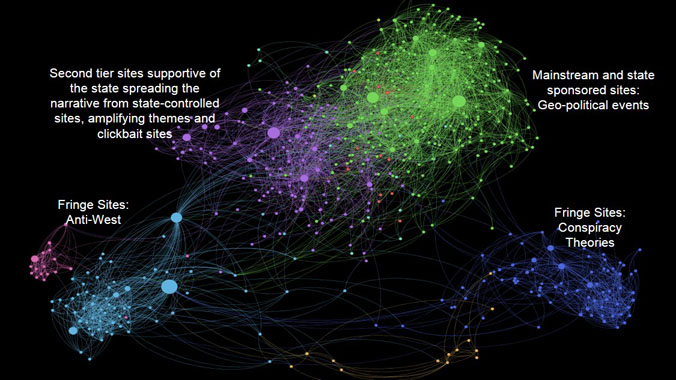
NATO was the subject of a number of specific disinformation attacks in the period March-June 2020, coinciding with the COVID-19 lockdown in many NATO Allies.
Over only two days (20-21 April), NATO detected three coordinated attacks against the presence of NATO troops in Latvia, Lithuania and Poland. These attacks included a fake letter, purportedly from NATO Secretary General Jens Stoltenberg to the Lithuanian Defence Minister Raimundas Karoblis, stating NATO’s intention to withdraw troops from the country, a fake interview claiming that Canadian troops in Latvia had brought the virus to the country, and a forged letter by a Polish military leader appearing to criticise US troops 3.
Over the same period, Russia spread false claims that NATO continued to hold large-scale exercises with no regard for limiting the spread of the virus. For example, Sputnik claimed the NATO exercise Steel Brawler in Latvia would put civilians at risk and increase the number of COVID-19 infections 4. It made similar claims about the BALTOPS maritime exercise in the Baltic Sea 5. Steel Brawler actually took place solely on military training grounds, specifically to avoid contact with the local population, and BALTOPS took place almost exclusively at sea 6.
The US-led exercise DEFENDER-Europe 20, which deployed thousands of US-based forces to Europe, was also a consistent target of disinformation 7 8. Due to the pandemic, the exercise was reduced in size and scope 9, yet Russian sources continue to claim it ignored travel restrictions and spread COVID-19 across Europe.
While criticising NATO exercises for potentially spreading the virus, the Russian military continued to hold exercises 10 during the pandemic. The Russian Minister of Defence announced the start of its routine summer military exercise programme 11, and that Russia will hold around 3,600 combat training events between June and September 2020.
As the coronavirus crisis spread, communications from China evolved and became more assertive 12, in what has been dubbed ‘Wolf Warrior’ diplomacy 13 or ‘mask diplomacy.’ The objective appears to be two-fold: to dismiss any criticism of China’s response to the pandemic, and to promote China as a responsible global leader with a superior model of governance.
To dismiss criticism, official Chinese sources have attempted to sow doubt about the origins of the virus, even blaming NATO Allies for its outbreak. The Chinese state-owned tabloid Global Times suggested in a tweet 14 that the virus may have originated in Italy, while the spokesman for China’s Foreign Ministry Zhao Lijian tweeted that the US Army may have brought the epidemic to Wuhan 15. Neither offered any evidence.
In April 2020, China’s embassy to France posted an article on its website claiming that local, French nursing home staff had abandoned residents “to die of hunger and disease”16. Jean-Yves Le Drian, France’s Minister for Europe and Foreign Affairs responded to ongoing remarks by the Chinese Embassy by summoning the Ambassador on 14 April. In a statement he described the actions of the Chinese Embassy as “not in keeping with the quality of the bilateral relationship” and expressed his disapproval 17.
While questioning the origins of the virus, Chinese state media have sought to highlight divisions between Allied responses to the pandemic and suggested that Western countries will not share a developed vaccine. A commentary on the state-controlled TV network CGTN claimed that NATO’s support to Allies and partners is ineffective 18.
Non-state actors have also attempted to exploit the pandemic in their communications. Terrorist groups have either tried to recruit new followers and mount attacks or to improve their public image. In its newsletter, Al Naba, the terrorist group ISIS claims that committing acts of terror makes jihadis immune to COVID-19 and that its supporters should take this opportunity to mount further attacks. Both ISIS and Al-Qaeda claim the pandemic is a manifestation of God’s wrath against ‘infidels’. Al-Qaeda is encouraging those in the West to use this time to study their teachings and convert to Islam.
Case studies
This section contains specific examples of COVID-19 related disinformation and propaganda that sought to bolster overarching anti-NATO narratives, many of which have been used at the same time, targeting different nations in different ways. The first is an in-depth study of one of several coordinated campaigns outlined in the second example.
Case study: Disinformation against NATO battlegroup in Lithuania
In April 2020, as part of a multi-phase disinformation operation, false claims were spread that an outbreak of COVID-19 within NATO’s multinational battlegroup in Lithuania had resulted in NATO’s decision to withdraw its troops.
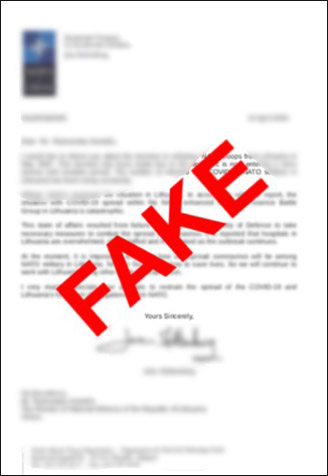
The false and misleading news content focused on a fake letter from NATO Secretary General Jens Stoltenberg to the Lithuanian Minister of Defence Raimundas Karoblis. The letter contained multiple false hostile narratives related to a rising number of COVID-19 infections among NATO troops and misleading details about Lithuania’s public health response to the pandemic.
Timestamps associated with the operation indicate that the campaign started with two blog posts, one in Lithuanian and one in English. Each version contained different false and misleading details about the local impact of COVID-19. The blogs were then shared across a number of fringe news websites and social media platforms using several single-use fake accounts, including one impersonating a real Lithuanian journalist. The accounts used were mostly created in the days prior to the original blog post, indicating the operation was carefully planned.
Beyond the fake letter and the supporting inauthentic news articles, the operation also included a manipulated YouTube video. This re-contextualized a press conference given by the Secretary General at the NATO Defence Ministers Meeting on 14 April 2020. The video was altered as if the conference was solely addressing the impact of COVID-19 on NATO’s troops in Lithuania.
The fake letter was then emailed directly to NATO Headquarters using a spoofed NATO Command email address. In spite of the effort to mimic official NATO communications, the email was poor quality and contained a number of formatting, syntax and grammatical errors that made its credibility questionable.
NATO Secretary General, Jens Stoltenberg, told the Baltic News Service: “They have not been successful because, first of all, it has been clearly revealed that this is a fake letter; secondly, we’ve seen that NATO allies remain committed, remain united, and are actually helping each other in the midst of the coronavirus crisis 19.”
Despite the clear planning and coordination involved, the campaign failed to gain any significant interest online, due to the fast response of the Lithuanian Defence Ministry 20 and close cooperation with NATO to debunk the story. The fringe blogs, news outlets, and social media posts failed to generate any significant interest, being shared less than 200 times.
Case study: Coordinated disinformation campaigns
Between 21 and 22 April 2020, Latvia, Lithuania and Poland were the target of concurrent multiphase disinformation campaigns. All three campaigns used the same tactics, techniques and procedures, and were part of a coordinated effort to provoke division within the Alliance. NATO worked quickly, in close coordination with Allies, in all three cases, to ensure the stories did not gain traction in mainstream media.
LATVIA
A fake interview and doctored screenshot from the Canadian-led NATO battlegroup in Latvia’s Facebook page falsely claimed that Canadian troops introduced COVID-19 to Latvia despite the quarantine measures in place.
The article was then laundered through multiple fringe blogs and media outlets. It was also emailed from a fake account purporting to belong to a Latvian journalist to the Latvian Minister of Defence in an attempt to provoke a response to the content.
LITHUANIA
A forged letter from the NATO Secretary General to the Lithuanian Defence Minister falsely claimed that NATO would withdraw its troops due to an outbreak of COVID-19 in the battlegroup in Lithuania.
In addition to the letter, a fabricated a news story and altered video was spread through a network of fringe blogs and media outlets, as well as YouTube.
As a final stage, the letter was emailed directly to NATO Headquarters using a spoofed NATO Command email address.
POLAND
A cyber-enabled disinformation operation planted a forged letter from Polish Brigadier General Ryszard Parafianowicz to the Polish War Studies Academy website criticising the US troop presence in Poland and the US-led exercise DEFENDER-Europe 20.
The article was laundered through multiple blogs and media outlets, as well as emailed to Polish media from an email address impersonating a former Member of Parliament in order to further its spread.
Each campaign used the following techniques:
FORGERIES
Low quality doctored letters, fake social media posts, and fake interviews.
FAKE PERSONAS
Single-use “burner accounts” created to share content and then abandoned
FALSEHOODS
Multiple false narratives regarding NATO and Allied unity and exercises during COVID-19.
AMPLIFICATION
Laundering of hostile narratives through fringe pro-Russian news sites.
LANGUAGE LEAP
Use of personas to help fabricated content make the leap to English-language media from their original source.
OUTREACH
Spoofed emails sent to NATO or other media entities to provoke a response.
Case study: NATO labs created COVID-19
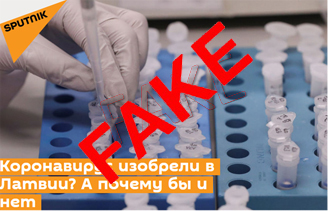
Russian state-controlled media and pro-Kremlin outlets suggested a Latvian lab could have developed the coronavirus. It also blamed ‘secret US/NATO laboratories’ in Georgia, Kazakhstan, Moldova and Ukraine for creating COVID-19 as a biological weapon. The existence of these labs in Georgia, Kazakhstan, Moldova and Ukraine is not a secret, and in fact, some of them have focused their resources to fight the pandemic.
The first Russian suggestion that COVID-19 may have originated in US military laboratories emerged on 20 January 2020, attributed to a Russian expert, on Zvezda TV 21, a state-owned network run by the Russian Ministry of Defence.
On 27 January, Kremlin-backed RenTV attempted to lay the blame for the pandemic on the Richard Lugar Center for Public Health Research in Tbilisi, a Georgia-based US biological laboratory. Russia had continued to imply that the US was operating secret labs in Georgia “at a time when the world should be uniting”.
Similarly, Russian disinformation has targeted a US lab in Kazakhstan, calling the Central Reference Laboratory in Almaty an “unregistered US and NATO military base” which is used to develop bio-weapons against Russia and China. Russian language website “Rhythm of Eurasia” published an article 22 alleging the COVID-19 virus was created by Kazakhstan scientists two years ago and that the US Department of Defense was behind the project.
On 21 April 2020, pro-Russian outlets in Moldova suggested it may become a “biological Chernobyl” as there is “a secret American biological laboratory” in which coronavirus itself could be created by humans and used as a biological weapon.
In late April and May, Russian state media made similar claims in numerous stories referring to 13 US-funded labs in Ukraine 23.
On 13 May 2020, the Russian Minister of Foreign Affairs Sergey Lavrov said: “Washington’s unwillingness to ensure the transparency of its military biological activities in various parts of the world raises questions about what is really going on there and what the actual goals are.”
Georgia’s Ministry of Foreign Affairs responded to “another falsehood on the functioning of the Richard Lugar Center for Public Health Research in Georgia” 24 and Georgian President Salome Zurabishvili rebuked Russia for its “slanderous statements about the Lugar Center”. 25
On 22 April, the US Embassy in Ukraine said, “The U.S. Department of Defense’s Biological Threat Reduction Program works with the Ukrainian Government to consolidate and secure pathogens and toxins of security concern in Ukrainian government facilities, while allowing for peaceful research and vaccine development” 26.
The Kazahk Foreign Ministry confirmed that “no biological weapons development is underway in Kazakhstan, and no research is conducted against any other states” 27.
Case study: Russian propaganda against Western media
In April, the Italian newspaper La Stampa was the target of a propaganda campaign by Russian officials. After the newspaper published a report questioning the usefulness of Russian aid to Italy, the author of the article was threatened in a Facebook post by the Russian Ministry of Defence Spokesperson, Igor Konashenkov that included a reference to the Latin proverb: “He that diggeth a pit, shall fall into it.” 28
Other Russian officials, including Foreign Minister Sergei Lavrov 29 and the Foreign Ministry Spokesperson Maria Zakharova 30, accused La Stampa of belittling Russian aid to Italy and spreading fake news and misinformation. The Italian Foreign and Defence Ministries condemned Igor Konashenkov’s tone and stressed that: “At this time of global emergency, the role of the free press to check and analyze remains more essential than ever” 31.
In an interview with La Stampa, referring to Igor Konashenkov’s statement, the NATO Deputy Secretary General Mircea Geoană said that any threat to journalists is “unacceptable and this is the real difference between free societies and countries that do not share our values” 32.
In May, Maria Zakharova accused the New York Times and the Financial Times of spreading disinformation about the COVID-19 death rate in Russia and threatened to take measures against the outlets if they did not publish a retraction 33 34. Maria Zakharova also criticized a report by Bloomberg and alleged that the NATO Secretary General launched a disinformation campaign aimed at discrediting Russia 35.
NATO Engages
NATO’s communications are based on real actions and facts. NATO and Allied armed forces have played a key role in supporting civilian efforts to fight COVID-19, with some 350 flights delivering hundreds of tons of critical supplies, the construction of almost 100 field hospitals, and almost half a million troops across the Alliance securing borders, transporting patients and helping with testing.
To ensure NATO is prepared for a possible second wave of COVID-19, Allies have agreed a new plan, a new stockpile of medical equipment, and a new fund for the quick acquisition of medical supplies. Many Allies have already offered to donate to the stockpile and contribute to the fund. This is a clear sign of Alliance unity and solidarity.
The practical support provided by NATO Allies to other Allies, as well as partners, has underpinned NATO’s communications on COVID-19.
NATO views fact-based, credible communications as the best way of countering disinformation. This is based on the Alliance’s core values of democracy, freedom of speech and the rule of law. Engaging the public and building resilience over the medium to long term is the most effective way to inoculate people against disinformation.
NATO will continue to expose disinformation through a wide range of media engagements including statements, rebuttals and corrections, and briefings to inform a wide variety of audiences about disinformation and propaganda, as it has since before the pandemic.
To meet the challenges of the current crisis, NATO has:
- Intensified digital communications on the pandemic response across all platforms. Ongoing COVID-19 related information and news stories can be found at www.nato.int/covid19.
- To shape the policy debate, NATO has turned public diplomacy face to face events into online engagements.
- Communications in Russian have been enhanced. This include articles, translations of factsheets, such as Russia’s 5 myths about NATO and COVID-19 36, and videos on our Russian language YouTube channel. To reach a broader audience, NATO routinely translates content into a range of languages.
NATO supports the work of independent NGOs, think tanks, academics, fact-checking organisations and other civil society initiatives to promote debate and to build resilience.
A pluralistic, independent media sector also plays an important role in countering disinformation and conveying factual information to the public. NATO engages with media to provide timely information on its response to COVID-19 to a potential audience of hundreds of millions of people. NATO has conducted briefings to media in multiple countries, including Georgia, Moldova, Russia and Ukraine and the Western Balkans region, focusing on disinformation and NATO’s contribution to the fight against COVID-19.
Coordination: Working with partners
Coordination with partners and international institutions underpins both the Understand and Engage strands of NATO’s response to disinformation. It is particularly important when dealing with a rapidly evolving crisis such as COVID-19.
To identify, analyze and counter disinformation, NATO works with the European Union through the European External Action Service 37 and the European Commission, the G7 Rapid Response Mechanism, the United Nations, and its Verified campaign and the US State Department’s Global Engagement Center. NATO’s active public diplomacy outreach and cooperation with partners globally strengthen our collective ability to address the challenge of disinformation.
Top tips to spot and counter disinformation
In a recent survey of 25 countries, eighty-six percent of citizens reported being exposed to fake news. Among them, nearly nine in ten reported having initially believed that the news was real 38. At NATO, we have experience in identifying, analyzing, and countering disinformation. These top tips can help citizens better spot and counter disinformation:
Top tips to spot disinformation and stop its spread
- Check the source: Look at your sources of information – who has published it and shared it? A site that does not clearly state editorial responsibility is not trustworthy. On social media, check an account’s handle or username – if it has many random letters and numbers in succession, it could be a bot. If you see an unverified account posting content hundreds of times a day, alarm bells should ring. You can try one of the free bot detectors, and online tools, such as NewsGuard, which flag and rate misinformation sites.
- Check the tone: Disinformation is often designed to trigger an emotional response. Be cautious of content that uses emotional language to elicit a strong reaction. Fear and anger are big drivers that allow disinformation to thrive.
- Check the story: Real news is usually covered by more than one source. If mainstream media are not picking up the story, there’s a good chance it can’t be confirmed. By running a search, you might find that independent fact-checkers have already debunked the story. Fact-checking sites, such as BBC Reality Check and AFP Fact Check, allow you to check the accuracy of stories.
- Check the images: Does an image show what it claims? Platforms like Google, TinEye, and Bing allow you to run a reverse image search to see where an image appears on the Internet and discover similar images. Tools and applications, such as SurfSafe and Serelay, can also help you determine whether an image has been doctored.
- Check your biases: Research indicates that people are much less likely to identify disinformation if it aligns with their own beliefs or preferences 39. Be smart and think about whether you are sharing content because you know it’s true or just because you agree with it.
Apply the tips above and THINK TWICE BEFORE YOU SHARE.
Top tips to counter disinformation or misinformation
- Proactive communications: When it comes to countering disinformation or misinformation, research shows that it’s more effective for authoritative figures to present accurate facts early and routinely, rather than to try to rebut every piece of disinformation after-the-fact. Try to identify and address knowledge gaps to reduce your audience’s susceptibility to disinformation.
- Pre-bunking: If people are made aware of the flawed reasoning found in disinformation or conspiracy theories, they may become less vulnerable to them. In this vein, social media companies have started posting warning labels about disinformation alongside content in news feeds.
- Flag common sources of disinformation: Identify and flag common sources of disinformation, such as certain websites or authors. This makes it harder for such sources to succeed in promoting new pieces of disinformation.
- Report and counter disinformation on the platform where it spreads: Facebook, Google, and Twitter all have their own systems to enable readers to report false information. It is important to report and debunk disinformation on the platform(s) where it originally spread. In this way, you have a better chance of reaching the audience that was misinformed.
- Pick your battles: To avoid rebutting thousands, if not millions of pieces of disinformation, it is important to prioritize. Evaluate the significance of a piece of disinformation before debunking. For instance, if a false story has not gained traction, debunking it could raise the profile of the story unnecessarily. Some experts argue that it’s better to wait until a piece of disinformation reaches a 10% penetration level amongst the public before it’s debunked.40
Conclusion
Disinformation, propaganda and misinformation have been a challenge for decades, but are especially dangerous during the COVID-19 crisis. Disinformation from both state and non-state actors attempts to divide Allies, undermine trust in democratic institutions and present authoritarian regimes as better at dealing with the health crisis. It also presents a risk to the public by undermining vital public health messages.
There is no single solution to disinformation. NATO cannot act alone. From international organisations and national and local governments, to private companies, civil society and a free and independent media, all actors – including NATO – have a part to play.
Citizens must be confident that the information they receive is correct. Working together, we are fighting the disease, protecting our citizens and beating disinformation 41.
- https://comprop.oii.ox.ac.uk/wp-content/uploads/sites/93/2019/09/CyberTroop-Report19.pdf
- https://www.graphika.com/reports/exposing-secondary-infektion/
- See case studies.
- https://lv.sputniknews.ru/analytics/20200413/13553446/Chumovye-manevry-NATO-Latvia-tseli-sredstva-veroyatnye-posledstviya.html
- https://sputnik-ossetia.ru/analytics/20200608/10694176/Protiv-kogo-napravleny-karlikovye-manevry-Pentagona-v-Polshe-i-ucheniya-NATO-v-Baltike.html
- https://news.usni.org/2020/06/11/baltops-2020-will-only-hold-at-sea-events-with-ships-commanded-from-shore
- https://www.rt.com/op-ed/480044-nato-defender-europe-russia/
- https://www.rt.com/news/483138-nato-defender-europe-coronavirus-drill/
- https://shape.nato.int/defender-europe/defender/newsroom/exercise-defendereurope-20-announcement-covid19-implications
- https://www.bbc.com/news/world-europe-53161450
- https://military.pravda.ru/news/1503578-shojgu_obyavil/
- https://www.gmfus.org/publications/masks-chinese-coronavirus-assistance-europe
- https://thediplomat.com/2020/05/interpreting-chinas-wolf-warrior-diplomacy/
- https://twitter.com/globaltimesnews/status/1241559268190343168
- https://twitter.com/zlj517/status/1238111898828066823?ref_src=twsrc%5Etfw%7Ctwcamp%5Etweetembed%7Ctwterm%5E1238111898828066823%7Ctwgr%5E&ref_url=https%3A%2F%2Feconomictimes.indiatimes.com%2Fnews%2Fdefence%2Fus-army-brought-coronavirus-epidemic-to-wuhan-chinese-diplomat%2Farticleshow%2F74607344.cms
- This story has since been removed. http://www.amb-chine.fr/fra/zfzj/t1768712.htm
- https://www.diplomatie.gouv.fr/en/country-files/china/news/article/communique-issued-by-m-jean-yves-le-drian-minister-for-europe-and-foreign
- https://news.cgtn.com/news/2020-04-03/NATO-s-poor-performance-in-fighting-COVID-19-PotPjIAWaI/index.html
- https://en.delfi.lt/politics/stoltenberg-provocation-in-lithuania-failed.d?id=84153213
- https://kam.lt/en/news_1098/current_issues/another_disinformation_attack_against_nato_presence.html?__cf_chl_jschl_tk__=82b4618bcb76f1169cffb5c148fafe2b748c723c-1594749166-0-AdUJtCXKU46AbY_JsDROnHCOcBlOWHfwYtUjCLtFVFigm3vbmZ_iap81Cum6hJbCIAnN7LF3jke9SSd4oDtydTGTFZhSIhPrZJkEaddaaLLeVrhGK_shNfeBS77oWDIda43WUl8mAiZmjZvUnOL1Jh1QWJjHO5gP4N2_OkvsRFf48B4J6Vuch_noWWLzQ2BR1BH9h1BnvMfwX0Yakf7kiFweUYHif7xulzxvOG9sKi5ZJun604pCJvmQZgGdq5h0SxR5RUo5djLrRAKnRKeIxvikNXNsCVYOvWfNujR3Zv9o4OGKarJY4KWJZGbGSyPfOFnfuvi6jF9sWVRBb-hjmfxyMXmAS0iGJV1-uhLM5Xc-UXlqvUtJ3IXvZ75V4RtYHJftY7F0-IIR1Ittpz0Fk4K9GyQ2ig2U9c2JMd9RPYTvli4_ZHxLDOFBGnD23AhCyQ
- https://tvzvezda.ru/news/vstrane_i_mire/content/2020120172-BPEmb.html
- https://www.ritmeurasia.org/news–2020-04-07–kazahstan-stanovitsja-placdarmom-biologicheskoj-vojny-48340
- https://sputniknews.com/europe/202004271079113315-ukraines-opposition-accuses-us-of-scrubbing-info-about-biolabs-activities-on-ukrainian-territory/
- https://mfa.gov.ge/News/sagareo-saqmeta-saministros-presisa-da-informa-(6).aspx?CatID=5&lang=en-US
- https://www.president.gov.ge/eng/pressamsakhuri/siakhleebi/saqartvelos-prezidenti-lugaris-laboratoriis-saqmia.aspx?fbclid=IwAR2dkabfhZryiUbeqn3QSpLSon-gK-nYYXyx9VYLZCVRBBEnNZvUeZUd4nI
- https://ua.usembassy.gov/u-s-ukraine-partnership-to-reduce-biological-threats/
- https://www.euractiv.com/section/central-asia/news/kazakhstan-fends-off-allegations-it-is-developing-biological-weapons/
- https://www.facebook.com/story.php?story_fbid=2608652339377506&id=1492252324350852&__tn__=*s*s-R
- https://www.mid.ru/en/web/guest/meropriyatiya_s_uchastiem_ministra/-/asset_publisher/xK1BhB2bUjd3/content/id/4099053
- https://www.mid.ru/en/web/guest/ukraine/-/asset_publisher/HfLxJk5I2xvu/content/id/4094236#4
- http://www.difesa.it/Primo_Piano/Pagine/COVID-19_Italia_grata_per_aiuti_dalla_Russia_rispetto_libert%C3%A0_espressione_stampa_nazionale.aspx
- https://www.lastampa.it/topnews/primo-piano/2020/04/04/news/mircea-geoana-la-nato-pronta-a-difendersi-anche-una-pandemia-puo-minacciare-la-sicurezza-1.38675629
- https://abcnews.go.com/Health/wireStory/russia-calls-nyt-ft-retract-stories-virus-toll-70676319
- https://tass.com/politics/1156151
- https://www.facebook.com/maria.zakharova.167/posts/10223114548881790
- NATO-Russia – Setting the record straight (https://www.nato.int/cps/en/natohq/115204.htm)
- https://eeas.europa.eu/sites/eeas/files/eu_nato_factshee_june-2020_3.pdf
- https://www.ipsos.com/en-us/news-polls/cigi-fake-news-global-epidemic
- https://www.ft.com/content/01622cd8-5303-11ea-90ad-25e377c0ee1f
- https://misinforeview.hks.harvard.edu/article/the-relation-between-media-consumption-and-misinformation-at-the-outset-of-the-sars-cov-2-pandemic-in-the-us/
- https://www.nato.int/cps/en/natohq/115204.htm
By NATO


